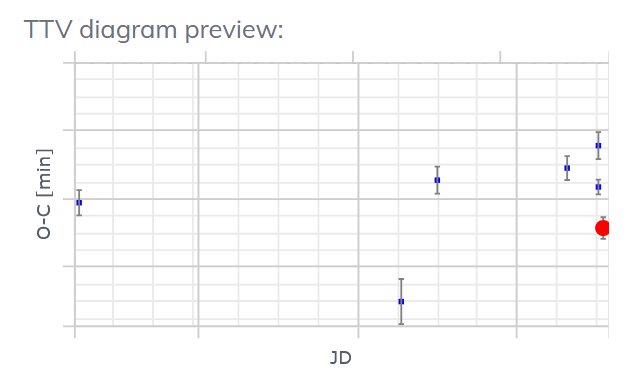Contribution by Dr. Gerold Holtkamp, June 2025
The measurements were taken from 22:32 UTC on March 27, 2025, to 4:27 UTC on March 28, 2025, in Osnabrück, Sonnenhügel. The moon was illuminated at 3% and 101° away. It was therefore not relevant for the measurement.
The measurement technique used:
Telescope: Skywatcher Newton 250/1200 mm
Mount: Skywatcher AZ-EQ6
Filter: Luminanz (Antlia)
Camera: QHY268M with gain 60, offset 20, chip temperature -10° C
Guiding: Skywatcher Guidescope Evoguide 50 ED with camera ZWO ASI120mm
NINA was used for camera and mount control.

The present measurement and the subsequent evaluation at ETD-VarAstro resulted in:
Rp/Rs = 0.0405+/- 0.00051 (expected 0.049) *
–> Rp = 0,0405 x 1.012.200 = 40.994 +/- 516 km. [1]
The exoplanet TOI-1298b is thus significantly smaller than Jupiter (radius = 69,911 km). Combined with its very large parent star, this results in a slight dip. It is 1,040 light-years from Earth.

The measured value of the deviation of the transit's temporal center from the expected value, O-C, is for most of the values listed in ETD-VarAstro.
The measurement of the transit light curve of the exoplanet TOI-1516b was published on the ETD-VarAstro homepage. [2]
_______________________________________________________________-
* [Rp = Rplanet, Rs = Rstar]
If the star's radius is known, the planet's radius is determined directly from the dip in the light curve. (see also https://kosmos-os.de/messung-der-transitlichtkurven-der-exoplaneten-wasp-84b-und-kps-1b-am-7-und-8-maerz-2024)
** [O = Observed, C = Calculated]
[1]
Data on the star system and the exoplanet at
https://exoplanetarchive.ipac.caltech.edu/overview/TOI-1298
The radius of the parent star was taken as 1.4536+0.0246/-0.0239 (MacDougall et al. 2023) x the radius of the Sun. The radius of the Sun was assumed to be 696,340 km. The parent star therefore has a radius of 1,012,200 km.
[2]
https://var.astro.cz/en/Observations/108195?transId=21104